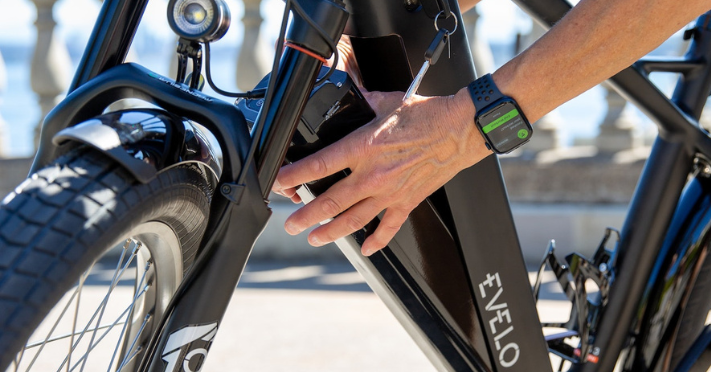The battery is arguably the most critical component of your electric bike. So proper battery storage is crucial to ensuring it retains performance, remains safe, and stays in the best shape possible during extended periods without use. This e-bike battery longevity guide will help you understand the dos and don’ts of battery storage, where to keep an e-bike battery and discover e-bike battery health tips.
Introduction to E-Bike Battery Storage
Storing e-bike batteries in a clean, dry, and safe location is crucial to ensuring they remain fully functional, maximizing battery care, avoiding damage, and preventing fire risks.
The Importance of Proper E-Bike Battery Storage
The performance of your e-bike battery is crucial to getting the maximum enjoyment out of your prized possession. Therefore, keeping your e-bike battery at room temperature in a dry location is vital to ensure optimal health.
Different Types of E-Bike Batteries and Their Storage Needs
Most modern e-bikes use lithium-ion batteries, but battery storage for optimal performance can depend on the type of e-bike batteries, of which there are plenty. These include:
- Lead Acid Batteries: These batteries are most commonly used on e-bikes worldwide and require the most attention. The batteries, also known as Sealed Valve Regulated Lead Acid batteries, offer low current when close to freezing temperatures, rapidly losing life, and heat the wires and other materials around them in high temperatures. They also self-discharge and must be charged at least every three months. Therefore, these batteries should be stored in a cool, dry place and charged monthly, should last for one to three years, and have a cycle life of around 300 rides.
- Nickel Metal Hydride batteries: Nickel Metal Hydride (NIMH) batteries were popular on early e-bikes but have limitations similar to those of lead-acid batteries. They’re more durable at high temperatures, won’t work in very cold conditions, and are self-discharging, so they ideally need to be recharged monthly. The batteries should offer more life, potentially up to 500 rides or ten years.
- Lithium Manganese batteries: These are the most common lithium batteries and can hold a charge for up to six months, if not longer. They’re best stored in cool, dry places and have a low risk of fire, but store the batteries away from heat sources.
- Lithium-Ion batteries: Most e-bikes now use lithium-ion batteries, like those powering your laptop and smartphone. These batteries have a long lifecycle of thousands of rides, and a high-quality one should last more than five years.
Ideal Conditions for Storing E-Bike Batteries
The first consideration when storing e-bike batteries long-term is the conditions in which the bike will be kept. For example, an e-bike battery should be stored in a location that isn’t clustered or could easily be knocked into and damaged. Also, avoid storing other items on top of the battery.
Temperature Considerations
The temperature of the location where you store your e-bike battery is crucial. The ideal battery storage temperature is between 40 to 70 °F at 40% to 50% charge, but that makes for a chilly house so room temperature is just fine.
Two situations are particularly destructive: storage below 30F with low charge, and storage above 80F when the battery is above 80% charge. Keep those batteries away from those conditions and you’ll be okay.
The Importance of Dry and Clean Storage
Safe battery storage practices also include choosing a dry and clean location. Avoid storing the battery near water sources or where a spillage could occur. Avoid dirty sites, as dust or mud could get into the battery and lead to damage or performance loss. Also, keep the battery away from doors and windows, which could risk moisture getting to the battery.
Battery Certification
Advocacy groups across the U.S., along with local officials and regulatory agencies, are pushing for improved safety certification of batteries, motors, and e-bikes following a significant increase in fires caused by the batteries used in e-bikes.
Be aware that just because something is marketed as UL 2849 compliant or even “certified to UL 2849 ” does not mean that it is UL safety certified. According to Ibrahim Jilani, UL’s Global Director of Consumer Technology, a manufacturer must earn the UL safety certification “upon successful demonstration of meeting the requirements of the safety standard.”. Stay up-to-date on the latest products certified to UL 2849. We recommend asking the brand from which you purchased your e-bike or battery for proof of certification.
Best Practices for Maintaining and Charging E-Bike Batteries
Charging your battery correctly and regular e-bike battery maintenance can help keep it safe and extend its lifecycle. Considerations here include:
The Charging Cycle and Its Impact on Battery Health
It can be tempting to stick your e-bike battery on charge before going to bed and leaving it powering up to the maximum overnight. However, overcharging an e-bike battery can reduce its long-term capacity, risk melting or overheating the battery, and impact its long-term performance.
Fully discharging a battery down to zero can also reduce its capacity and affect its ability to hold a charge long-term, so e-bike battery charging tips are to have it somewhere in the middle. Another essential consideration is only using the correct charger, even if a similar charger seems compatible, as this could damage the e-bike battery.
Maintenance Tips for Battery Terminals and Connections
You may be thinking, “Oh my gosh! This is a lot.” Well, it doesn’t have to be. Remember these quick tips for battery terminal and connection maintenance:
- Regularly checking the connections, cables, and terminals can also contribute to prolonging the e-bike battery lifespan.
- Keeping the battery clean, even by wiping it down with a damp cloth, is a good start, but also regularly grease the terminals and connections.
- Avoid using a hose or high-pressure jet when cleaning, as this could cause damage to the battery or connections.
Regular Testing and Monitoring of Battery Health
If you plan to store your bike for an extended period, such as through the winter months, try to avoid locking it away and forgetting about it. Leaving a battery uncharged for several months can result in a loss of performance when you come to use it again.
For example, Juiced Bikes advises: “If you’re not riding during the winter, it’s important to store your battery inside and at the right charge level. Keep your charge at 50% capacity when storing.”
Precautions for E-Bike Battery Storage
A few additional battery preservation tips should be considered before leaving your e-bike battery in storage. For example:
Avoiding Potential Fire Hazards
It goes without saying that your e-bike battery shouldn’t be stored anywhere near potential fire hazards. Lithium-ion batteries can be hazardous, so avoid heat sources and anything flammable.
Handling and Transporting E-Bike Batteries Safely
E-bike batteries can be volatile and dangerous if they aren’t handled properly. Lithium-ion batteries use combustible lithium powder that can explode when they come into contact with oxygen, which means a high risk of it catching fire if you attempt to open it. So if your battery is faulty, avoid opening it at all costs and take it to a professional rather than trying to examine or repair it yourself.
Dealing with Damaged or Old Batteries
Modern e-bike batteries manufactured by UL Safety Certified companies are generally safe and very high-quality. However, all batteries deteriorate over time, and the most common reason for failure is faulty connections or losing capacity over time after repeated use.
When your e-bike battery does fail, it’s vital to know how to dispose of them. You can either get it refurbished or recycled by an expert or take it to an official battery recycling center. However, never throw your battery in the trash or recycling bin, as it’s dangerous and potentially illegal.
A good resource for safely disposing of your e-bike battery is the National eBike Battery Recycling Program, which has over 50 brands on board and over 1,800 drop-off locations nationwide. Also, Call2Recycle aims to administer the safe collection and recycling of e-bike batteries working with e-bike manufacturers and riders.



